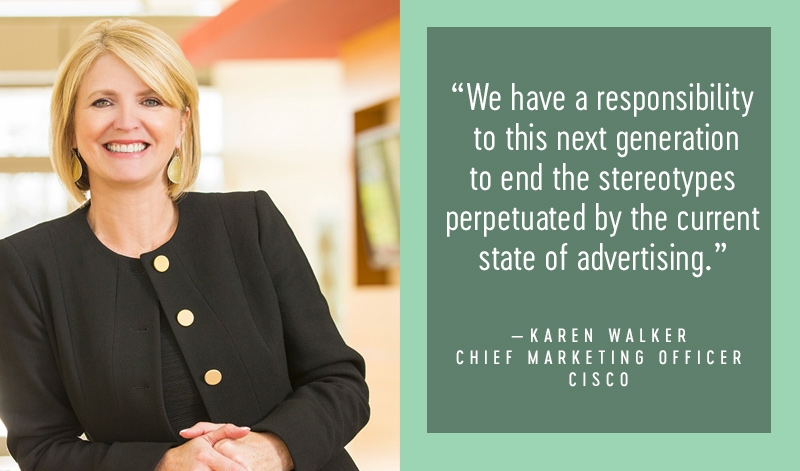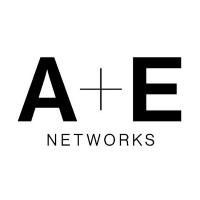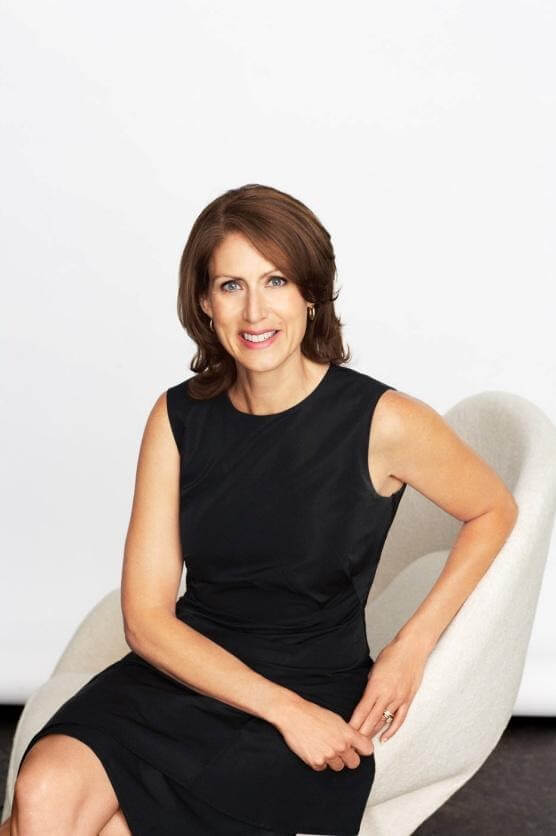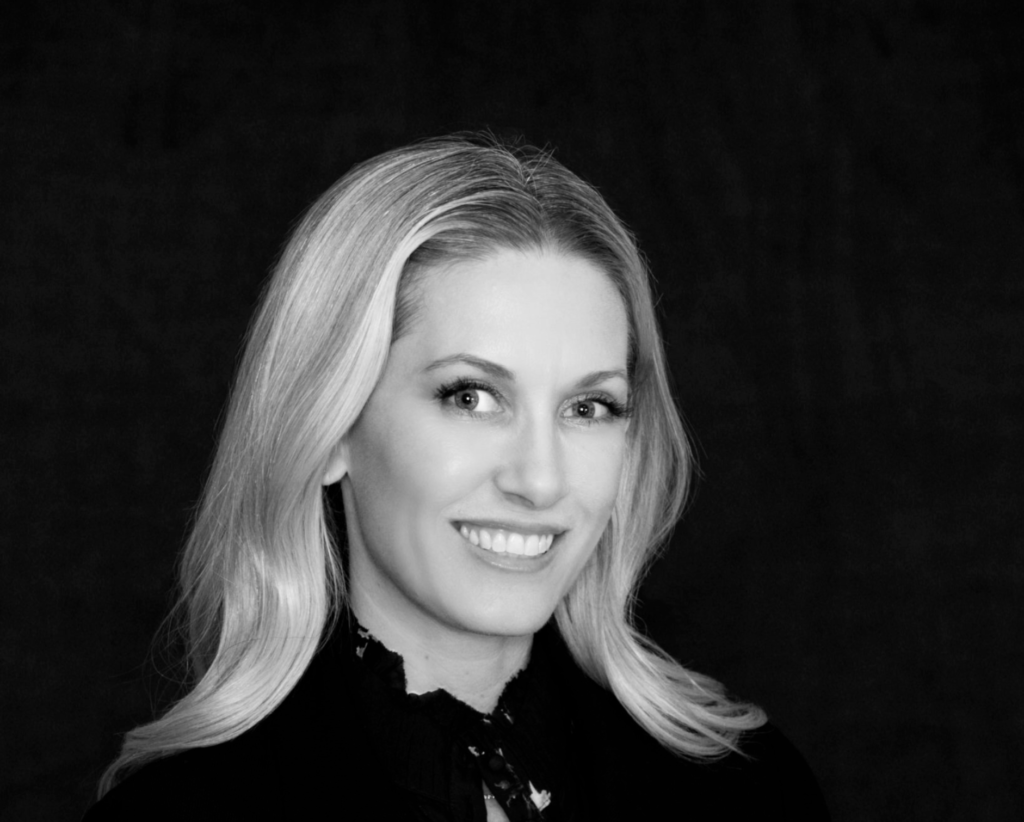

Cisco is a B2B behemoth in the male-heavy network-infrastructure business. It’s also dedicated to using its marketing muscle to create depictions of smart, empowered women in its advertising. Karen Walker, the company’s chief marketing officer, recently spoke to SheReports about what motivates her to fight stereotypes and how a B2B brand can do that just as effectively as a consumer-facing one.
Cisco announced earlier this year that you’d be joining the #SeeHer initiative. What drove you to sign on?
Originally it was because I was shocked by stats that Unilever found in their research about how women are portrayed in advertising. The research they did showed that only 3 percent of ads show women in leadership positions, 2 percent show women as intelligent and 1 percent show women with a sense of humor. I felt a responsibility to play my part as a CMO and board member of the Association of National Advertisers, which started the movement.
But an additional motivation was that I have a strong, very smart and independent daughter who represents our future. We have a responsibility to this next generation to end the stereotypes perpetuated by the current state of advertising.
That said, our marketing won’t change significantly because we were already taking action to create content that was a better representation of the world. One example was our video, “The Network’s Sixth Sense,” in which we cast a female as the lead network director. Committing to the #SeeHer initiative provided momentum to give that video even greater impact.
We have a responsibility to this next generation to end the stereotypes perpetuated by the current state of advertising.
Cisco is primarily a B2B business in an industry that’s hugely male-dominated. How do you balance the #SeeHer goals around increasing the representation of women in your marketing with the reality of who your customers are?
We put the customer at the center of everything we do — particularly when it comes to our marketing messages. That means that we’re putting the customer’s care-abouts and pain points at the center of how we position the value of our products and services. While there are fewer female engineers, they experience the same pain points as male engineers, so I don’t think it makes too much of a difference whether we use a man or a woman.
At a brand campaign level, we have a great opportunity to tell our story in a way that appeals to all genders. This is why we used Peter Dinklage for our Network. Intuitive. campaign in June 2017 and Millie Bobby Brown for our Collaboration campaign, which launched in May. As two of the most influential actors in two of the most popular shows today, I think we can safely say they appeal to all groups of people.
While there are fewer female engineers, they experience the same pain points as male engineers, so I don’t think it makes too much of a difference whether we use a man or a woman.
Additionally, we also see our role in the tech industry as encouraging more women to come into our industry — so if that means we overrepresent reality a little bit, we’re fine with that. We want to change it. And all those male engineers have sisters, daughters and female friends in their lives who they want to see in tech, too.
More generally, how can B2B companies work to support the goals of #SeeHer?
Business buyers are becoming more like consumers in how they’re buying, completing up to two-thirds of their buying journey online. Therefore, we optimize around the assets that help a customer understand our solutions — that means all the content and creative we place on cisco.com, the emails we are sending to help our customers along their buying journey, the speakers we invite to events and so on. We have a tremendous opportunity to carry out the goals of #SeeHer in these spaces that are as important to us as TV advertising might be to our B2C peers.
Additionally, we also see our role in the tech industry as encouraging more women to come into our industry — so if that means we overrepresent reality a little bit, we’re fine with that. We want to change it.
I also think we have an amazing opportunity to make a dent in the stat from Unilever that only 3 percent of ads show women as intelligent. There are so many amazing, smart, professional women working in our industry and in other B2B industries, and we should be leveraging those opportunities within our own marketing creative.
What other efforts is Cisco making to help increase female representation in tech?
At Cisco, tech is what we do, but making an impact on the world together is who we are. We have made a commitment to positively impact 1 billion people by the year 2025. As part of that, we have a number of initiatives that support female representation in technology. Every year, we organize the Girls Power Tech program, which takes place at over 100 locations around the world to inspire girls to get excited about tech careers.
I also think we have an amazing opportunity to make a dent in the stat from Unilever that only 3 percent of ads show women as intelligent.
Another big part of our effort to have an impact is through our Cisco Networking Academy. The Networking Academy is committed to educating the next generation of talent with the technology skills needed to solve some of the world’s toughest challenges. In fiscal 2017, more than 1.3 million people enrolled in Networking Academy across 180 countries, and 24 percent of them were female. Some countries had female participation rates over 40 percent, including Peru, United Arab Emirates and Nigeria.
We are so optimistic about the impact technology will have on society, and we are ensuring women and girls have equal access to contributing to that impact.
More From the Tech Issue of SheReports:
- Woman to Watch: iconectiv’s Tara Flynn Condon
- Challenging Stereotypes and Teaching Women to Code
- The Power of Cultivating Dignity
- Younger Women Are More Connected
- Younger Women Want Stronger Depictions
- Returnships Set Sail
- Programmed In
- The Future May Be Female, but Does Your Voice-Activated Assistant Need To Be?
- #Goodtech’s Good Deeds
- July 15, 2006: Twitter Was Launched, Opening Up a New Platform for Women’s Voices




